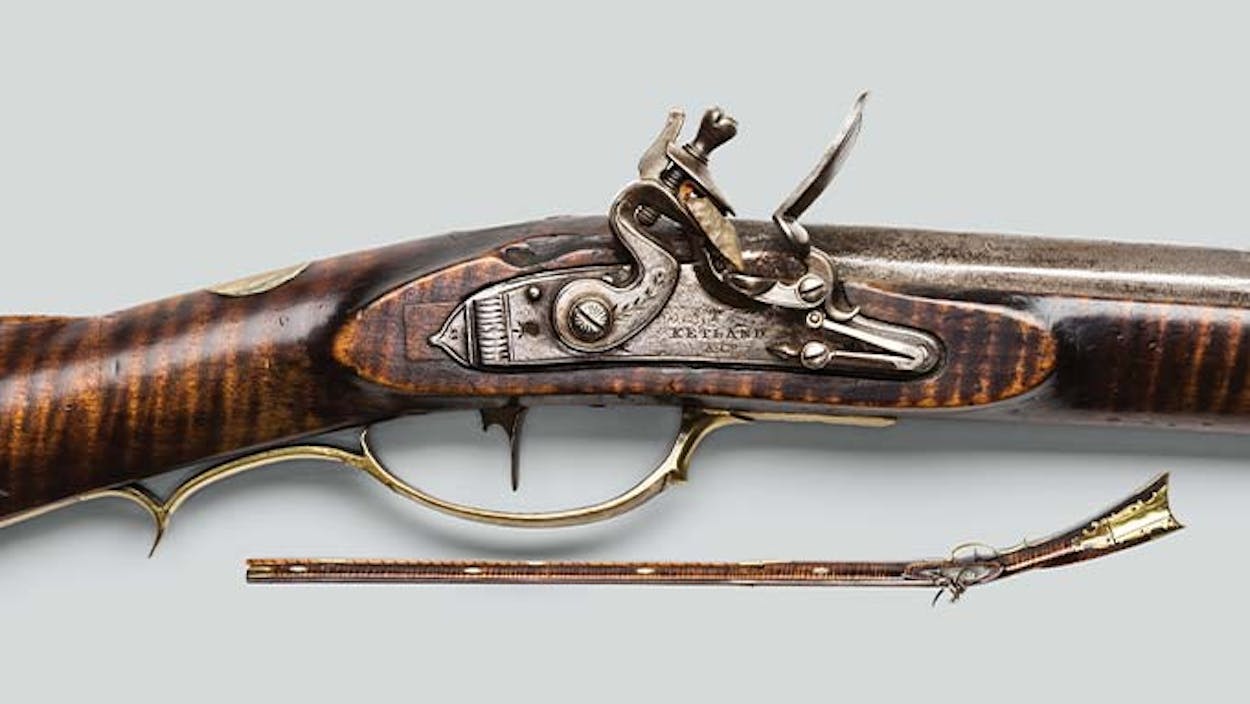The ragtag group that marched from Gonzales to San Antonio de Béxar in October 1835 was a bring-your-own-gun army. This volunteer force, led by Stephen F. Austin, called itself the Army of the People, and the people supplied their own weapons and equipment. When the call to arms came, the soldiers picked up whatever was handy and brought it with them.
Robert Hancock Hunter, who was living in what is now Fort Bend County when he joined the company, succinctly described the army’s weaponry in his memoirs, which he wrote in 1860 and in which he employed his own spelling style: “We had about 150 men, & our guns were no a count, little dobble barrels shot guns. Some men had rifels. I had a Harperferry yauger. The lock was tide on with a buck skin string & the stock & barrel was tide to geather with buckskin strings.” Some men may have had rifles, but others had no firearms at all. While the army was still assembling at Gonzales, Austin wrote, “Arms and ammunition are needed; we have more men than guns.”
Hunter’s “yauger” was a Jaeger (a German word for “hunter”) rifle, a gun with a 36-inch barrel manufactured at the United States Armory and Arsenal at Harper’s Ferry, Virginia. The “rifels” the rebels used were Pennsylvania long rifles, described by colonist and frontier blacksmith Noah Smithwick as “long, single-barreled, muzzle-loading flintlock rifles, the same that our fathers won their independence with and that the famous Kentucky brigade used with such telling effect at the battle of New Orleans.” Pennsylvania gunsmiths, mostly Germans, made these rifles from about 1725 to the early 1800’s. Their octagonal barrels were 40 to 48 inches long, and they fired .35- to .60-caliber balls. Their stocks were walnut or maple and were often heavily ornamented in brass, with boxes set into them that contained the patches used for loading. In the hands of a skilled marksman, they were accurate at more than two hundred yards.
The 300-man Army of the People left Gonzales on October 12 and reached the outskirts of San Antonio eight days later. For years San Antonio had been the capital of Spanish and Mexican Texas, and the rebels thought that if they could capture it, the revolution would be over. The town was defended by a garrison of 650 Mexican troops under the command of General Martín Perfecto de Cos. The Texas soldiers surrounded the town, blocking the roads leading into it to cut off the arrival of Mexican reinforcements.
Most of the Mexicans were armed with English-made Brown Bess muskets, smoothbore guns with a range of about seventy yards. In one of the opening skirmishes of the siege, at Mission Concepción, the Texans’ Pennsylvania rifles picked off the Mexican artillerymen, who were powerless to retaliate. One Texas veteran wrote, “We wondered to see that their balls often fell short of us.” Several Texans, he went on, were “struck by balls which were far too spent to break the skin, and only caused an unpleasant bruise.”
The siege of San Antonio dragged on until December 5, when Ben Milam and Frank Johnson led two columns into town. Four days of bloody house-to-house fighting followed. Creed Taylor, one of the participants, later remembered that the Pennsylvania rifles were particularly effective in that kind of fighting. “No sooner did a head appear above a wall,” he wrote, “than it was the target for a dozen hunting rifles, and there was always another dead Mexican.” On December 9 Cos surrendered and marched his army south, leaving the Texans in control of San Antonio.
The Army of the People disbanded after the battle of San Antonio. Most of Austin’s volunteers went home, some of them went off on a harebrained expedition to capture Matamoros (they failed), and about one hundred men under the command of James C. Neill forted themselves up in the Alamo with the cannons that Cos had left behind. In mid-January 1836, Sam Houston, who was appointed commander in chief of the regular army by the provisional government, sent James Bowie and a company of volunteers to reinforce Neill, suggesting to the provisional government that Bowie destroy the Alamo and abandon San Antonio. That never happened, and we know what came next: General Antonio López de Santa Anna arrived with his army on February 23. By March 6 the Alamo was in ruins and its defenders were dead.
Though the Texans carried hundreds of weapons into the Alamo, few of those survived. A Mexican citizen of San Antonio, pressed into service by the Santa Anna soldiers to carry the bodies of the dead defenders to their funeral pyre, found a Pennsylvania long rifle in the ruins. He later gave it to Frank Johnson, who had not stayed behind to defend the Alamo. Johnson considered the gun a suitable gift for William Carr Lane, the mayor of St. Louis, Missouri, when he made a trip there in 1839. It changed hands several more times before coming into the possession of a retired Army colonel living in San Antonio named Walter Siegmund, who donated it to the Alamo in 1947, where it has been displayed ever since.
The gun is a fine example of the most effective weapon of the Texas revolution. It was made by Jacob Dickert, a master gunsmith of Lancaster County, Pennsylvania. The stock is curly maple, with an elaborately ornamented brass patch box set into it and eight oval German silver inlays under the octagonal barrel. The barrel itself is 45 inches long, with Dickert’s name stamped on the top. No one knows who carried this beautiful weapon into the Alamo, but it is on display in the shrine not far from where the defender must have fallen.
The Alamo, 300 Alamo Plaza, San Antonio (210-225-1391). Open daily 9–5:30.







